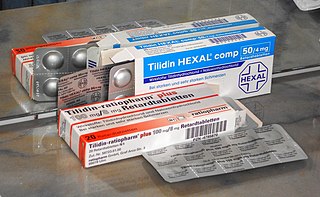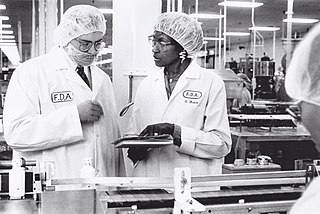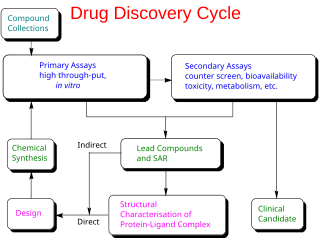
Pharmacology is a branch of medicine, biology, and pharmaceutical sciences concerned with drug or medication action, where a drug may be defined as any artificial, natural, or endogenous molecule which exerts a biochemical or physiological effect on the cell, tissue, organ, or organism. It is the science of drugs including their origin, composition, pharmacokinetics, therapeutic use, and toxicology. More specifically, it is the study of the interactions that occur between a living organism and chemicals that affect normal or abnormal biochemical function. If substances have medicinal properties, they are considered pharmaceuticals.

A medication is a drug used to diagnose, cure, treat, or prevent disease. Drug therapy (pharmacotherapy) is an important part of the medical field and relies on the science of pharmacology for continual advancement and on pharmacy for appropriate management.

The pharmaceutical industry discovers, develops, produces, and markets drugs or pharmaceutical drugs for use as medications to be administered to patients, with the aim to cure them, vaccinate them, or alleviate symptoms. Pharmaceutical companies may deal in generic or brand medications and medical devices. They are subject to a variety of laws and regulations that govern the patenting, testing, safety, efficacy using drug testing and marketing of drugs. The global pharmaceuticals market produced treatments worth $1,228.45 billion in 2020 and showed a compound annual growth rate (CAGR) of 1.8%.

In the fields of medicine, biotechnology and pharmacology, drug discovery is the process by which new candidate medications are discovered.

Drug design, often referred to as rational drug design or simply rational design, is the inventive process of finding new medications based on the knowledge of a biological target. The drug is most commonly an organic small molecule that activates or inhibits the function of a biomolecule such as a protein, which in turn results in a therapeutic benefit to the patient. In the most basic sense, drug design involves the design of molecules that are complementary in shape and charge to the biomolecular target with which they interact and therefore will bind to it. Drug design frequently but not necessarily relies on computer modeling techniques. This type of modeling is sometimes referred to as computer-aided drug design. Finally, drug design that relies on the knowledge of the three-dimensional structure of the biomolecular target is known as structure-based drug design. In addition to small molecules, biopharmaceuticals including peptides and especially therapeutic antibodies are an increasingly important class of drugs and computational methods for improving the affinity, selectivity, and stability of these protein-based therapeutics have also been developed.

Medicinal or pharmaceutical chemistry is a scientific discipline at the intersection of chemistry and pharmacy involved with designing and developing pharmaceutical drugs. Medicinal chemistry involves the identification, synthesis and development of new chemical entities suitable for therapeutic use. It also includes the study of existing drugs, their biological properties, and their quantitative structure-activity relationships (QSAR).
A biological target is anything within a living organism to which some other entity is directed and/or binds, resulting in a change in its behavior or function. Examples of common classes of biological targets are proteins and nucleic acids. The definition is context-dependent, and can refer to the biological target of a pharmacologically active drug compound, the receptor target of a hormone, or some other target of an external stimulus. Biological targets are most commonly proteins such as enzymes, ion channels, and receptors.
The American Association for Cancer Research (AACR) is the world's oldest and largest professional association related to cancer research. Based in Philadelphia, the AACR focuses on all aspects of cancer research, including basic, clinical, and translational research into the etiology, prevention, diagnosis, and treatment of cancer. Founded in 1907 by 11 physicians and scientists, the organization now has more than 52,000 members in 130 countries and territories. The mission of the AACR is to prevent and cure cancer through research, education, communication, collaboration, science policy and advocacy, and funding for cancer research.
The Cancer Genome Project is part of the cancer, aging, and somatic mutation research based at the Wellcome Trust Sanger Institute in the United Kingdom. It aims to identify sequence variants/mutations critical in the development of human cancers. Like The Cancer Genome Atlas project within the United States, the Cancer Genome Project represents an effort in the War on Cancer to improve cancer diagnosis, treatment, and prevention through a better understanding of the molecular basis of the disease. The Cancer Genome Project was launched by Michael Stratton in 2000, and Peter Campbell is now the group leader of the project. The project works to combine knowledge of the human genome sequence with high throughput mutation detection techniques.
The Institute of Microbial Technology (IMTECH), based in Chandigarh, India, is one of the constituent establishments of the Council of Scientific & Industrial Research (CSIR). It was established in 1984.

Nature Reviews Drug Discovery is a monthly peer-reviewed review journal published by Nature Portfolio. It was established in 2002 and covers drug discovery and development. The editor-in-chief is Peter Kirkpatrick. According to the Journal Citation Reports, the journal has a 2021 impact factor of 112.288, ranking it 1st out of 158 journals in the category "Biotechnology & Applied Microbiology" and 1st out of 279 journals in the category "Pharmacology & Pharmacy".

Cytotherapy is a peer-reviewed medical journal covering the areas of cell and gene therapy. The journal was established in 1999 and the Senior Editor is Donald G. Phinney. It is published by Elsevier on behalf of the International Society for Cell & Gene Therapy (ISCT).
Santaris Pharma A/S was a biopharmaceutical company founded in 2003 in Copenhagen, Denmark. The company also had a branch in San Diego, California that opened in 2009. Created by a merger between Cureon and Pantheco, Santaris developed RNA-targeted medicines using a Locked Nucleic Acid (LNA) Drug Platform and Drug Development Engine.
SLAS Discovery is a peer-reviewed scientific journal published by the Society for Laboratory Automation and Screening (SLAS) in partnership with SAGE Publications. The editor-in-chief is Robert M. Campbell, Ph.D.. The journal explores how scientists develop and utilize novel technologies and/or approaches to provide and characterize chemical and biological tools to understand and treat human disease. This includes scientific and technical advances in target identification/validation; biomarker discovery; assay development; virtual, medium- or high-throughput screening; lead generation/optimization; chemical biology; and informatics. The journal was published from 1996 through 2016 with the title Journal of Biomolecular Screening. Its name changed in 2017 to more accurately reflect the evolution of its editorial scope.[1]

LifeArc is a British life science medical research charity. It was established in 2000 as MRC Technology to translate the work of UK Medical Research Council (MRC) research scientists.
Phenotypic screening is a type of screening used in biological research and drug discovery to identify substances such as small molecules, peptides, or RNAi that alter the phenotype of a cell or an organism in a desired manner. Phenotypic screening must be followed up with identification and validation, often through the use of chemoproteomics, to identify the mechanisms through which a phenotypic hit works.
Insilico Medicine is a biotechnology company based in Pak Shek Kok, Hong Kong in Hong Kong Science Park near the Chinese University of Hong Kong, and in New York, at The Cure by Deerfield. The company combines genomics, big data analysis, and deep learning for in silico drug discovery.

Drug repositioning is the repurposing of an approved drug for the treatment of a different disease or medical condition than that for which it was originally developed. This is one line of scientific research which is being pursued to develop safe and effective COVID-19 treatments. Other research directions include the development of a COVID-19 vaccine and convalescent plasma transfusion.

COVID-19 drug development is the research process to develop preventative therapeutic prescription drugs that would alleviate the severity of coronavirus disease 2019 (COVID-19). From early 2020 through 2021, several hundred drug companies, biotechnology firms, university research groups, and health organizations were developing therapeutic candidates for COVID-19 disease in various stages of preclinical or clinical research, with 419 potential COVID-19 drugs in clinical trials, as of April 2021.








